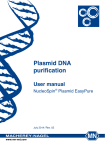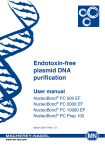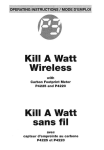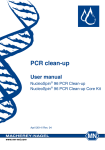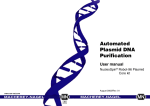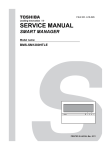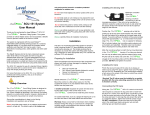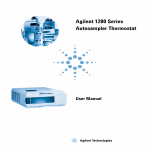Download Plasmid and large-construct DNA purification - MACHEREY
Transcript
Plasmid and large-construct DNA purification User manual NucleoSpin® 96 Flash April 2014 / Rev. 04 Plasmid and large construct DNA purification Table of contents 1 Components 4 1.1 Kit contents 4 2 Product description 5 2.1 The basic principle 5 2.2 Kit specifications 5 2.3 Required hardware 6 2.4 Automated processing on robotic platforms 6 2.5 Growth of bacterial cultures 7 2.5.1 Selection of culture media 2.5.2 Cultivation of bacteria in a Square-well Block 2.5.3 Cultivation of bacteria in tubes 2.5.4 Recommendations for the cultivation of large low-copy constructs (e.g., BACs) 3 Storage conditions and preparation of working solutions 7 7 7 8 9 4 Safety instructions 10 5Protocols 12 5.1 High-copy plasmid purification – manual processing 15 5.2 High-copy plasmid purification – automated processing 18 5.3 Large low-copy construct DNA purification – automated and manual processing20 6Appendix 23 6.1Troubleshooting 23 6.2 Ordering information 25 6.3 Product use restriction / warranty 25 MACHEREY-NAGEL – 04 / 2014, Rev. 04 3 Plasmid and large construct DNA purification 1 Components 1.1 Kit contents NucleoSpin® 96 Flash 2 x 96 preps 4 x 96 preps 24 x 96 preps1 740618.2 740618.4 740618.24 Resuspension Buffer F1 100 mL 250 mL 6 x 250 mL Lysis Buffer F2 100 mL 250 mL 6 x 250 mL Neutralization Buffer F3 125 mL 250 mL 6 x 250 mL Buffer FE2 60 mL 60 mL 6 x 60 mL RNase A (lyophilized)3 25 mg 50 mg 6 x 50 mg NucleoSpin® Flash Filter Plate (dark yelow rings) 2 4 24 Culture plate 2 4 24 Square-well Block (precipitation plate) 2 4 24 Gas-permeable Foil4 2 4 24 Self-adhering Foil5 10 20 120 User manual 1 1 6 REF 1 2 3 4 5 The kit for 24 x 96 preparations (REF 740618.24) consists of 6 x REF 740618.4. Composition of Buffer FE: 5 mM Tris/HCl, pH 8.5 For preparation of working solutions and storage conditions see section 3. Every MN Square-well Block (culture plate) includes a Gas-permeable Foil. For ordering information, please contact Technical Service. Use of Self-adhering PE Foil (REF 740676) is not recommended. 4 MACHEREY-NAGEL – 04 / 2014, Rev. 04 Plasmid and large construct DNA purification 2 Product description 2.1 The basic principle With the NucleoSpin® 96 Flash procedure, plasmid DNA is liberated from the E. coli host cells by SDS / alkaline lysis after resuspension of the pelleted bacteria (buffers F2 and F1, respectively). The resulting lysate is then neutralized by addition of Buffer F3 – cell debris will precipitate together with SDS. Incubation in boiling water (optional) inactivates nucleases which are present in a variety of E. coli host strains and denatures soluble proteins and other cell constituents. Afterwards, all precipitates are removed by filtration of the lysate through the NucleoSpin® 96 Flash Filter Plate under vacuum or in a suitable centrifuge for microtiter plates. Plasmid DNA is precipitated by addition of isopropanol to the filtrate and subsequent centrifugation. After an additional washing step with 70 % ethanol and drying, the DNA can be resuspended in Buffer FE (5 mM Tris / HCl, pH 8.5). 2.2 Kit specifications • NucleoSpin® 96 Flash is designed for the rapid manual and automated 96well DNA preparation of high and low copy-number plasmids and large lowcopy constructs (e.g., BACs, bacterial artificial chromosomes) DNA from E. coli cultures. • For the isolation of DNA from large low-copy DNA such as BACs, see section 5.3. • The kit is for use under vacuum (common laboratory automation workstations, see section 2.4), NucleoVac 96 Vacuum Manifold (see ordering information) or similar suitable vacuum manifolds (see section 2.3) or in a centrifuge (see section 2.3). The final precipitation requires the use of a centrifuge capable to spin a Square-well Block with at least 2,500 x g. • The kit allows the rapid parallel purification of up to 8 μg of highly pure plasmid DNA from 1.1–1.3 mL of a saturated E. coli culture per preparation in the convenient 96-well format. • The prepared plasmid DNA is suitable for many automated fluorescent DNA sequencing applications, PCR, or many types of enzymatic manipulation. • Time for manual parallel processing of up to 384 plasmid DNA Mini preps from E.coli cultures with NucleoSpin® 96 Flash is less than 90 min. MACHEREY-NAGEL – 04 / 2014, Rev. 04 5 Plasmid and large construct DNA purification Kit specifications at a glance Parameter NucleoSpin® 96 Flash Technology Alkaline lysis with subsequent filtration and precipitation Format 96-well plates Processing Manual or automated, vacuum or centrifugation (centrifuge required for precipitation) Lysate clarification 96-well filter plates Sample material 1.1–1.3 mL E. coli culture Vector size < 250 kbp Typical yield 8 μg from 1.1–1.3 mL E. coli culture (high-copy plasmid) 1 μg from 1.3–3.9 mL E. coli culture (BACs) Preparation time 90 min/2 plates 2.3 Required hardware Harvesting of bacterial cells and plasmid precipitation is achieved in a centrifuge with a swinging-bucket rotor attaining ≥ 2,500 x g. Clearance of the buckets must be sufficient to accommodate square-well blocks (height: 44 mm). For clearing of the neutralized and heat-incubated lysate, a NucleoVac 96 Vacuum Manifold is required for manual use of NucleoSpin® 96 Flash. If using a centrifuge with a swing-out rotor capable to accommodate the NucleoSpin® Flash Filter Plate / Square-well Block sandwich (bucket height: 85 mm), no NucleoVac 96 vacuum manifold is necessary and the whole procedure can be performed in the centrifuge. Shorter centrifugation times are sufficient, if the centrifuge is capable of attaining 6,000 x g. 2.4 Automated processing on robotic platforms NucleoSpin® 96 Flash can be used fully automated on many common laboratory workstations. For the availability of scripts and general considerations about adapting NucleoSpin® 96 Flash on a certain workstation, please contact MN. Visit MN online at www.mn-net.com or contact your local MACHEREY-NAGEL distributor for technical support regarding hardware, software, setup instructions, and selection of the protocol. 6 MACHEREY-NAGEL – 04 / 2014, Rev. 04 Plasmid and large construct DNA purification 2.5 Growth of bacterial cultures 2.5.1 Selection of culture media The cultivation of cells is recommended at 37 °C in LB (Luria-Bertani) medium at constant shaking (200–250 rpm). Alternatively, rich media like 2 x YT or TB (Terrific Broth) can be used. By using 2 x YT or TB, bacteria grow faster and reach the stationary phase much earlier than in LB medium (≤ 12 h) in culture tubes or flasks. This may lead to a higher percentage of dead or starving cells when starting the preparation. The resulting plasmid DNA from overgrown cultures may be partially degraded or contaminated with chromosomal DNA. 2.5.2 Cultivation of bacteria in a Square-well Block Use the 96-well Square-well Block for growing bacteria. Add 1.2–1.5 mL of selected medium (with appropriate antibiotic; for example 100 μg/mL ampicillin) to each well of the Square-well Block. To avoid cross-contamination due to spillage during incubation, do not exceed a total culture volume of 1.5 mL. Inoculate each well with a single bacterial colony. Cover the Square-well Block with the Gas-permeable Foil supplied with the Square-well Block. Grow the culture in a suitable incubator at 37 °C for 16– 24 h with vigorous shaking (200–400 rpm). The Square-well Block may be fixed to the shaker with large-size flask clamps (for 2-L flasks) or tape. Note: The yield of plasmid DNA depends on growth conditions, bacterial strain, and cell density of the culture, as well as on the size and copy number of the vector. Use of high-copy number plasmids such as pUC, pBluescript, or pGEM and E. coli strains such as DH5α or XL1 Blue are recommended. Growth times of 16–24 h are usually sufficient. However, for poorly growing bacteria, prolonged incubation times of up to 30 h may be required. 2.5.3 Cultivation of bacteria in tubes Use 1–5 mL of appropriate culture medium. Depending on the bacterial strain and copy number of the plasmid, up to 5 mL LB medium or 2.5 mL 2 x YT or 2.5 mL TB medium can be used. Grow bacteria with vigorous shaking (200–250 rpm) for 10–14 h. Optional: If the liquid handling instrument does not allow for the use of selected culture tubes, transfer the bacterial culture from the tubes into a suitable Square-well Block. Transfer 1.5 mL of the culture to each well of the Square-well Block. Harvest the cultures by centrifugation. Discard supernatant. Usually 1.5 mL of culture are sufficient for DNA preparation. However, if necessary, add additional 1.0–1.5 mL bacterial culture to each well of the Square-well Block, centrifuge again, and discard the supernatant. Do not use more than 5 mL LB culture or 2.5 mL rapid growing bacterial strain (using 2 x YT or TB medium) because lysis efficiency might be lower when using cell pellets which are too large. MACHEREY-NAGEL – 04 / 2014, Rev. 04 7 Plasmid and large construct DNA purification 2.5.4 Recommendations for the cultivation of large low-copy constructs (e.g., BACs) • Use a freshly prepared preculture to inoculate cultures for BAC DNA preparation. Using a preculture gives higher reproducibility and more consistent results. • Grow precultures in a Square-well Block. Use 150 μL to 1.2 mL of LB or 2 x YT medium with an appropriate antibiotic. Grow with vigorous shaking 300–400 rpm at 37 °C for 16 h. Alternatively, grow 100–150 μL preculture using a standard Microtiter plate (u-bottom) with shaking at 180 rpm. Inoculate precultures with single colonies or glycerol stocks. Note: Direct inoculation of cultures for BAC DNA preparation from single colonies or glycerol stocks (without preculture) may result in lower yields and less reproducible results due to higher differences in yields. Use a suitable pin-tool for 96-well plates or 8-channel pipette to inoculate the culture. Avoid repeated freeze / thaw cycles of BAC glycerol stocks. Use replicate plates or prepare fresh glycerol stocks for frequent use. 8 • Inoculate cultures for BAC DNA peparation from the precultures. Dilute 1:1000 (1 μL of preculture per 1 mL of medium with appropriate antibiotic (e.g., 25 μL/ mL kanamycin or 12.5 μg/mL chloramphenicol) using a suitable pin-tool or 8-channel pipette. • When growing BAC cultures in 96-well plates, use up to 3 cultures of 1.3 mL per preparation (see ordering information for additional Square-well Blocks and Gas-permeable Foils). • Alternatively, use suitable 48-well deep well blocks for culturing BACs. Use 2.5 mL of a suitable culture medium. • Grow cultures for 16 h at 37 °C with shaking. Use the supplied Gas-permeable Foil to cover the Culture Plate. Discard preculture or prepare new glycerol stocks from preculture. • Harvest bacteria by centrifugation. Centrifuge culture for 10 min at 2,500 x g. When using more then one culture for preparation of DNA from a clone combine corresponding cultures. • Use a suitable centrifuge rotor with a clearance of 44 mm to accommodate the square well Culture Plates. Discard medium after centrifugation by inverting the plate quickly. Remove residual culture medium by tapping the plate on a filter paper. MACHEREY-NAGEL – 04 / 2014, Rev. 04 Plasmid and large construct DNA purification 3 Storage conditions and preparation of working solutions Attention: Buffer F2 contains SDS and sodium hydroxide which are irritant and hazardous. Wear gloves and goggles! • Store bottles tightly closed at all times. Buffer F2 will absorb CO2 if exposed to air. This leads to a decreasing pH, resulting in suboptimal kit performance. • Sodium dodecyl sulfate (SDS) in Buffer F2 may precipitate if stored at temperatures below 20 °C. If a precipitate is observed in Buffer F2, incubate the bottle at 30–40 °C for some minutes and mix well until all of the precipitation is redissolved. • If you are using the NucleoSpin® 96 Flash manually, establish a reliable vacuum source for the NucleoVac 96 Vacuum Manifold. The manifold may be used with a vacuum pump, house vacuum, or water aspirator. We recommend a vacuum of 0.2–0.4 bar (reduction of atmospheric pressure). The use of the NucleoVac Vacuum Regulator (see ordering information) is recommended. Alternatively, adjust vacuum that during the purification the sample flows through the column with a rate of 1–2 drops per second. Before starting any NucleoSpin® 96 Flash protocol, prepare the following: • Before first use of the kit, add 1 mL Buffer F1 to the RNase A vial and vortex. Transfer all of the resulting solution into the Buffer F1 bottle and mix thoroughly. Indicate the date of RNase A addition. Store Buffer F1 containing RNase A at 4 °C. The solution will be stable at this temperature for at least six months. MACHEREY-NAGEL – 04 / 2014, Rev. 04 9 Plasmid and large construct DNA purification 4 Safety instructions GHS classification Only harmful features do not need to be labeled with H and P phrases up to 125 mL or 125 g. Mindergefährliche Eigenschaften müssen bis 125 mL oder 125 g nicht mit H- und P-Sätzen gekennzeichnet werden. Component Hazard contents GHS symbol Hazard Precaution phrases phrases Inhalt Gefahrstoff GHS Symbol H-Sätze P-Sätze F2 Sodium hydroxide 0.5–2.0 % Warning Natriumhydroxid-Lösung 0.5–2.0 % Achtung 290, 315, 319 234, 280, 302+352, 305+351+338, 332+313, 337+313, 390, 406 RNase A, lyophilized Danger 317, 334 261, 280, 302+352, 304+340, 333+313, 342+311, 363 RNase A RNase A, lyophilisiert Gefahr Hazard phrases H 290 May be corrosive to metals. H 315 Causes skin irritation. H 317 May cause an allergic skin reaction. H 319 Causes serious eye irritation. H 334 May cause allergy or asthma symptoms or breathing difficulties if inhaled. Kann gegenüber Metallen korrosiv sein. Verursacht Hautreizungen. Kann allergische Hautreaktionen verursachen. Verursacht schwere Augenreizung. Kann bei Einatmen Allergie, asthmaartige Symptome oder Atembeschwerden verursachen. Precaution phrases P 234 Keep only in original container. P 261 Avoid breathing dust. P 280 Wear protective gloves / eye protection. P 302+352 IF ON SKIN: Wash with plenty of water/… P 304+340 IF INHALED: Remove victim to fresh air and keep at rest in a position comfortable for breathing Nur im Originalbehälter aufbewahren. Einatmen von Staub vermeiden. Schutzhandschuhe / Augenschutz tragen. Bei Kontakt mit der Haut: Mit viel Wasser/… waschen. Bei Einatmen: An die frische Luft bringen und in einer Position ruhigstellen, die das Atmen erleichtert. 10 MACHEREY-NAGEL – 04 / 2014, Rev. 04 Plasmid and large construct DNA purification P 305+351+338 IF IN EYES: Rinse continuously with water for several minutes. Remove contact lenses if present and easy to do – continue rinsing. BEI KONTAKT MIT DEN AUGEN: Einige Minuten lang behutsam mit Wasser spülen. Vorhandene Kontaktlinsen nach Möglichkeit entfernen. Weiter spülen. P 332+313 If skin irritation occurs: Get medical advice / attention. P 333+313 If skin irritation occurs: Get medical advice / attention. P 337+313 Get medical advice / attention. P 363 Wash contaminated clothing before reuse. P 390 Absorb spillage to prevent material damage. P 406 Store in a corrosive resistant container with a resistant inner liner. Bei Hautreizung: Ärztlichen Rat einholen / ärztliche Hilfe hinzuziehen. Bei Hautreizung- oder -ausschlag: Ärztlichen Rat einholen / ärztliche Hilfe hinzuziehen. Bei anhaltender Augenreizung: Ärztlichen Rat einholen / ärztliche Hilfe hinzuziehen. Kontaminierte Kleidung vor erneutem Tragen waschen. Verschüttete Mengen aufnehmen, um Materialschäden zu vermeiden. In korrosionsbeständiger Auskleidung aufbewahren. For further information please see Material Safety Data Sheets (www.mn-net.com). Weiterführende Informationen finden Sie in den Sicherheitsdatenblättern (www.mn-net.com). MACHEREY-NAGEL – 04 / 2014, Rev. 04 11 High-copy plasmid purification – manual processing 5 Protocols Protocol-at-a-glance 1 Cultivate and harvest bacterial cells 1.5 mL–5 mL LB or up to 2.5 mL 2 x YT or TB 1,000 x g, 10 min 2 Resuspend bacterial cells 300 μL F1 Mix or shake 3 Lyse bacterial cells 300 μL F2 RT, 2–5 min (Optional: shake) 4 Neutralize 300 μL F3 (Optional: mix or shake) Prepare vacuum manifold for lysate clearing step 5 Heat incubation (optional) 100 °C, 5 min 6 Transfer crude lysates to NucleoSpin® Flash Filter Plate 7 Clear crude lysates directly into Squarewell Block -0.2 to -0.4 bar*, 1–5 min or 1,500 x g, 1–5 min 8 Precipiate DNA 630 μL isopropanol (0.7 volumes) ≥ 2,500 x g, 15 min * Reduction of atmospheric pressure 12 MACHEREY-NAGEL – 04 / 2014, Rev. 04 High-copy plasmid purification – manual processing 9 Wash pellet 700 μL ethanol (70 %) ≥ 2,500 x g, 3 min 10 Dry pellet 55 °C, 10 min 11 Resuspend DNA 20–50 μL FE MACHEREY-NAGEL – 04 / 2014, Rev. 04 13 High-copy plasmid purification – manual processing Setup of vacuum manifold: Step 4: Place the NucleoSpin® Flash Filter Plate on top of the manifold. Step 3: Place the manifold lid on top of the manifold base. Step 2: Place the Square-well Block into the manifold. SQ UA SQ UA 14 RE -W EL LB LO CK RE -W EL LB LO CK Step 1: Insert spacers`SQUARE-WELL BLOCK‘ in the manifold base. MACHEREY-NAGEL – 04 / 2014, Rev. 04 High-copy plasmid purification – manual processing 5.1 High-copy plasmid purification – manual processing • For hardware requirements, refer to section 2.3. • For detailed information regarding the vacuum manifold setup, see page 15. Before starting the preparation: • 1 Check if Buffer F1 was prepared according to section 3. Cultivate and harvest bacterial cells Pellet the bacteria by centrifuging the Square-well Block (leave Gas-permeable Foil on the block) at 1,000 x g for 10 min. Remove the Gas-permeable Foil and invert the block quickly to pour off the supernatant. Tap the block on a paper sheet or paper towels in order to remove as much of the remaining medium as possible. 2 Resuspend bacterial cells Add 300 μL Buffer F1 with RNase A to each bacterial pellet and resuspend the cells by vortexing. Be sure that all of the RNase A has been added to Buffer F1 (see section 3). Vortex the block until no more cell clumps or pellets are visible in the wells. 3 Lyse bacterial cells Add 300 μL Buffer F2 to each well. Seal the block thoroughly with Self-adhering Foil and make sure the foil sticks to the walls between the wells to prevent wellto-well cross contamination. Mix by gently inverting the block 3–4 times. Incubate at room temperature for up to 5 min. Do not vortex. Remove Self-adhering Foil and dry the upper rim of the wells with a paper towel. The bacterial suspension should become clear as cell lysis occurs. Vortexing at this step will shear the genomic bacterial DNA, leading to contamination of the resulting plasmid DNA preparation. Do not extend the cell lysis to more than 5 min. 4 Neutralize Add 300 μL Buffer F3 to each well. Seal the block thoroughly with Self-adhering Foil and make sure the foil sticks to the walls between the wells to prevent wellto-well cross contamination. Mix gently by inverting 3–4 times. A white precipitate of SDS and cell debris forms. MACHEREY-NAGEL – 04 / 2014, Rev. 04 15 High-copy plasmid purification – manual processing 5 Heat incubation (optional) If using endA+ host strains: Seal the block with a fresh Self-adhering Foil and incubate it in a boiling water bath for 5 min. Let the block cool down on ice to at least room temperature. This heating step can be omitted when using endA- host strains like DH5α or XL-1 Blue. Check with the host / plasmid system you use if boiling is necessary. When using endA+ strains like E. coli HB101, heat destruction of endonuclease activities is essential. Another benefit of heat treatment is denaturation of proteins and other cell constituents that have not been precipitated by alkaline lysis, making their removal during the following filtration step possible. Prepare the NucleoVac 96 Vacuum Manifold Prepare manifold for filtration of crude lysates (see page 15): Insert spacers labeled ‘SQUARE-WELL BLOCK’ notched side up into the grooves located on the short sides of the manifold base. Place a new Square-well Block into the manifold base, close the lid and insert the NucleoSpin® Flash Filter Plate into the lid. If using a centrifuge with a swing-bucket rotor capable of hosting 96-well blocks plus the NucleoSpin® Flash Filter Plate, place the NucleoSpin® Flash Filter Plate on a fresh Square-well Block, apply lysates from step 4, and centrifuge for 2 min at 2,500 x g. Proceed directly to step 8. 6 Transfer crude lysates onto the NucleoSpin® Flash Filter Plate Transfer the crude lysates resulting carefully and completely into the wells of the NucleoSpin® Flash Filter Plate. 7 Clear crude lysate by vacuum filtration Apply vacuum of -0.2 to -0.4 bar* until all of the samples have passed the wells (typically < 5 min). It may be necessary to cover unused wells with a rubber pad if the vacuum does not build up immediately. If using a centrifuge with a swing-bucket rotor capable of hosting 96-well blocks plus the NucleoSpin® Flash Filter Plate, place the NucleoSpin® Flash Filter Plate on a fresh Square-well Block, apply lysates from step 4, and centrifuge for 2 min at 2,500 x g. 16 MACHEREY-NAGEL – 04 / 2014, Rev. 04 High-copy plasmid purification – manual processing 8 Precipitate DNA Remove the Square-well Block from the vacuum manifold. Add 630 μL (0.7 volumes) isopropanol to each well. Close the block with a Self-adhering Foil and mix by inverting the block 6–8 times. Centrifuge the block for 15 min at ≥ 2,500 x g. 9 Wash pellet Remove the foil and discard the supernatant by inverting the block quickly. Tap the block on blotting paper or paper towels. Add 700 μL ethanol (70 %) per well and seal block again. Centrifuge at 2,500 x g for 3 min. 10 Dry pellet Remove foil and discard the supernatant by inverting the block quickly. Tap the block on paper sheet or paper towels. Dry the pellets at 50–55 °C for 10–15 min in an incubator or oven until no more ethanol droplets are visible. Ethanol is an inhibitor of many enzymatic reactions. Drying of the pellets is also possible at room temperature. However, for optimal removal of ethanol from the preparation, heat incubation is recommended. 11 Resuspend DNA Add 50 μL Buffer FE (5 mM Tris-HCl, pH 8.5) and vortex the block briefly. Optional: Close the block again with a foil and incubate at 50–55 °C for 10– 15 min. Centrifuge briefly before removing the foil. This step is recommended to speed up the resuspension of DNA if you intend to use it for immediately following downstream applications. If higher DNA concentrations are desired, the plasmid DNA can be resuspended in 20 μL Buffer FE as well. The sealed block can conveniently be used for storage of the plasmid DNA at +4 °C or -20 °C. Quantify the yield of plasmid DNA by agarose gel electrophoresis before setting up sequencing reactions: compare aliquots of the Mini preps to supercoiled plasmid DNA standards with known concentration. We recommend usage of ~1 μg of plasmid DNA for fluorescent dye primer and ~0.5 μg for fluorescent dye terminator cycle sequencing. * Reduction of atmospheric pressure MACHEREY-NAGEL – 04 / 2014, Rev. 04 17 High-copy plasmid purification – automated processing 5.2 High-copy plasmid purification – automated processing Note: The list numbers in this protocol do not correspond to the numbers in section 6.1. Required hardware: • Suitable vacuum manifold Before starting the preparation: • 1 Check if Buffer F1 was prepared according to section 3. Cultivate and harvest bacterial cells Pellet the bacteria by centrifuging the Square-well Block (leave gas permeable foil on the block) at 1,000 x g for 10 min. Remove the cover foil and invert the block quickly to pour off the supernatant. Tap the block on blotting paper or paper towels in order to remove as much of the remaining medium as possible. It is strictly recommended to centrifuge the bacteria cultures under these conditions. Centrifugation at higher g-forces might produce tight pellets which are more difficult to resuspend. Optional: If centrifugation at higher g-forces is used, a shaker integrated on the robot worktable will be necessary for complete resuspension of the bacterial pellet after addition of Buffer F1. 2 Before placing the Culture Plate in the desired position of the robot worktable, briefly vortex the block on a suitable vortexer. This brief vortexing step will ensure an easy and complete resuspension of the pellet after addition of Buffer F1. 3 Add buffers to the reservoirs or place the buffer bottles in the corresponding positions of the robot worktable. Place the plastic equipment like plates and the assembled vacuum manifold in the locations as specified in the individual robot program. Optional: Buffer FE (5 mM Tris / HCl, pH 8.5) may be substituted by nuclease-free water (check pH is 8.0–8.5 before use). This is recommended if the eluted DNA has to be concentrated for downstream applications or Tris salts interfere with downstream applications. A concentration of Tris higher than 10 mM can interfere with common sequencing chemistries. * Reduction of atmospheric pressure 18 MACHEREY-NAGEL – 04 / 2014, Rev. 04 High-copy plasmid purification – automated processing 4 Select method or program for DNA purification. Optional: After transfer to the NucleoSpin® Flash Filter Plate, incubate crude lysates for 1–3 min on the plate. This incubation allows the formation of a compact white precipitate. This step is usually not required for culture volumes up to 1.5 mL. 5 After addition of 0.7 volumes of isopropanol to each well by the robot, remove the Square-well Block from the vacuum manifold. 6 Centrifuge the block for 15 min at ≥ 2,500 x g. Remove the foil and discard the supernatant by inverting the block quickly. Tap the block on blotting paper or paper towels. 7 Add 500 μL ethanol (70 %) per well and seal block again. Centrifuge at 2,500 x g for 3 min. Remove foil and discard the supernatant as described above (step 7). Tap the block on blotting paper or paper towels. Dry the pellets at 50–55 °C for 10–15 min in an incubator or oven until no more ethanol droplets are visible. Ethanol is an inhibitor of many enzymatic reactions. Drying of the pellets is also possible at room temperature. However, for optimal removal of ethanol from the preparation, heat incubation is recommended. 8 Add 50 μL Buffer FE (5 mM Tris / HCl, pH 8.5) and vortex the block briefly. Optional: Close the block again with a foil and incubate at 50–55 °C for 10– 15 min. Centrifuge briefly before removing the foil. This step is recommended to speed up the resuspension of DNA if you intend to use it for immediately following downstream applications. If higher DNA concentrations are desired, the plasmid DNA can be resuspended in 20 μL Buffer FE as well. The sealed block can conveniently be used for storage of the plasmid DNA at +4 °C or -20 °C. Quantify the yield of plasmid DNA by agarose gel electrophoresis before setting up sequencing reactions: compare aliquots of the Mini preps to supercoiled plasmid DNA standards with known concentration. We recommend usage of ~1 μg of plasmid DNA for fluorescent dye primer and ~0.5 μg for fluorescent dye terminator cycle sequencing. MACHEREY-NAGEL – 04 / 2014, Rev. 04 19 Large low-copy construct DNA purification – automated and manual processing 5.3 Large low-copy construct DNA purification – automated and manual processing Please see section 2.5.4 for recommendations regarding the cultivation of large lowcopy constructs (e.g., BACs) Required hardware: • Suitable vacuum manifold Before starting the preparation: • 1 Check if Buffer F1 was prepared according to section 3. Cultivate and harvest bacterial cells Pellet the bacteria by centrifuging the Square-well Block (leave Gas-permeable Foil on the block) at 2,500 x g for 10 min. Remove the Gas-permeable Foil and invert the block quickly to pour off the supernatant. Tap the block on a paper sheet or paper towels in order to remove as much of the remaining medium as possible. When growing cultures in several Square-well Blocks, combine cultures by subsequent centrifugation steps. 2 Resuspend bacterial cells Add 300 μL Buffer F1 with RNase A to each bacterial pellet and resuspend the cells by vortexing. Be sure that all of the RNase A has been added to Buffer F1 (see section 3). Vortex the block until no more cell clumps or pellets are visible in the wells. 3 Lyse bacterial cells Add 300 μL Buffer F2 to each well. Seal the block thoroughly with Self-adhering Foil and mix by gently inverting the block 10–15 times. Incubate at room temperature for up to 5 min. Do not vortex. Remove Self-adhering Foil and dry the upper rim of the wells with a paper towel. The bacterial suspension should become clear as cell lysis occurs. Vortexing at this step will shear the genomic bacterial DNA, leading to contamination of the resulting plasmid DNA preparation. Do not extend the cell lysis to more than 5 min. 4 Neutralize Add 300 μL Buffer F3 to each well. Seal the block thoroughly with new Selfadhering Foil and mix gently by inverting 10–15 times. A white precipitate of SDS and cell debris forms. 20 MACHEREY-NAGEL – 04 / 2014, Rev. 04 Large low-copy construct DNA purification – automated and manual processing 5 Heat incubation (optional) If using endA+ host strains: Seal the block with a fresh Self-adhering Foil and incubate it in a boiling water bath for 5 min. Let the block cool down on ice to at least room temperature. This heating step can be omitted when using endA- host strains like DH5α or XL-1 Blue. Check with the host / plasmid system you use if boiling is necessary. When using endA+ strains like E. coli HB101, heat destruction of endonuclease activities is essential. Another benefit of heat treatment is denaturation of proteins and other cell constituents that have not been precipitated by alkaline lysis, making their removal during the following filtration step possible. Prepare the NucleoVac 96 Vacuum Manifold Prepare manifold for filtration of crude lysates (see page 18): Insert spacers labeled ‘SQUARE-WELL BLOCK’ notched side up into the grooves located on the short sides of the manifold base. Place a new Square-well Block into the manifold base, close the lid and insert the NucleoSpin® Flash Filter Plate into the lid. If using a centrifuge with a swing-bucket rotor capable of hosting 96-well blocks plus the NucleoSpin® Flash Filter Plate, place the NucleoSpin® Flash Filter Plate on a fresh Square-well Block, apply lysates from step 4, and centrifuge for 2 min at 2,500 x g. Proceed directly to step 8. 6 Transfer crude lysates onto the NucleoSpin® Flash Filter Plate Transfer the crude lysates resulting carefully and completely into the wells of the NucleoSpin® Flash Filter Plate. 7 Clear crude lysate by vacuum filtration Apply vacuum of -0.2 to -0.4 bar* until all of the samples have passed the wells (typically < 5 min). It may be necessary to cover unused wells with a rubber pad if the vacuum does not build up immediately. MACHEREY-NAGEL – 04 / 2014, Rev. 04 21 Large low-copy construct DNA purification – automated and manual processing 8 Precipitate DNA Remove the Square-well Block from the vacuum manifold. Add 630 μL (0.7 volumes) of isopropanol to each well. Close the block with a Self-adhering Foil and mix by inverting the block 6–8 times. Optional: Add 2 mg of glycogen or other carrier for precipitation. Centrifuge the block for 30 min at 6,000 x g at room temperature. Use of a refrigerated centrifuge is recommended. For centrifugation at lower g-forces prolonged centrifugation times are required (e.g., 60 min at 2,000 x g). 9 Wash pellet Remove the foil and discard the supernatant by inverting the block quickly. Tap the block on blotting paper or paper towels. Add 700 μL ice-cold ethanol (70 %) per well and seal block again. Centrifuge at 6,000 x g for 10 min. For centrifugation at lower g-forces prolonged centrifugation times are required (e.g., 15 min at 2,000 x g). 10 Dry pellet Remove foil and discard the supernatant as described in step 9. Tap the block on paper sheet or paper towels. Dry the pellets at room temperature for at least 10–15 min in an incubator or more ethanol droplets are visible. Ethanol is an inhibitor of many enzymatic reactions. Drying of the pellets is also possible at room temperature. However, for optimal removal of ethanol from the preparation, heat incubation is recommended. 11 Resuspend DNA Add 25–30 μL Buffer FE (5 mM Tris-HCl, pH 8.5), seal the block with Selfadhering Foil, and incubate the block overnight at room temperature. A vortexer or shaker may be used to enhance resuspension when DNA is used for sequencing purposes. Using a vortexer or resuspending by pipetting up and down may cause shearing which might interfere in some mapping applications. Quantify the yield and quality of BAC DNA by agarose gel electrophoresis before setting up sequencing reactions: use an aliquot of 5 μL for restriction analysis. Incubate with 5–10 units of an appropriate restriction endonuclease for 1 h. Separate the digested BAC DNA on an 0.7 % agarose gel and stain with ethidium bromide. A pattern of distinct fragments should be visible. 22 MACHEREY-NAGEL – 04 / 2014, Rev. 04 Plasmid and large construct DNA purification 6 Appendix 6.1 Troubleshooting Problem Possible cause and suggestions Cell pellet not properly resuspended • Incomplete lysis of bacterial cells It is essential that the cell pellet is completely resuspended prior to lysis. No cell clumps should be visible before addition of Lysis Buffer F2. If necessary, increase number of mixing cycles or duration of shaking. SDS in Buffer F2 precipitated • SDS in Buffer F2 may precipitate upon storage. If this happens, incubate Buffer F2 at 30–40 °C for 5 min and mix well. Too many bacterial cells used • Usage of LB as the growth medium is recommended. When using rich media like TB or 2 x YT, cultures volumes have to be reduced (see section 5). No or not enough antibiotic used during cultivation • Poor plasmid yield Cells harbouring the plasmid of interest may become overgrown by non-transformed cells. Add appropriate amounts of freshly prepared stock solutions to all media, solid and liquid. Bacterial cultures are too old • See suggestions in section 5 ‘Growing of bacteria cultures’. Incomplete lysis of bacterial cells • See ‘Possible cause and suggestions’ above. MACHEREY-NAGEL – 04 / 2014, Rev. 04 23 Plasmid and large construct DNA purification Problem Possible cause and suggestions Excessive mixing steps after addition of Buffer F2 and Buffer F3, or before transfer of crude lysate to the NucleoSpin® Flash Filter Plate • High level contamination with chromosomal DNA Mix by gentle inversion of the sealed culture block. Culture volume was too high • Reduce culture volume if lysate is too viscous for gentle and complete mixing. Bacterial culture overgrown • Overgrown bacterial cultures contain lysed cells and degraded DNA. See suggestions in section 5 ‘Growing of bacteria cultures’. Lysis was too long • Lysis step must not exceed 5 min. Resuspension of plasmid DNA with TE buffer • Suboptimal performance of plasmid DNA in sequencing reactions, problems with downstream applications 24 EDTA may inhibit enzymatic reactions like DNA sequencing. Repurify the plasmid DNA and elute with AE buffer or nucleasefree water. Alternatively, the plasmid DNA may be precipitated with ethanol, and redissolved in Buffer FE or nuclease-free water. Not enough DNA used for sequencing reactions • Quantify DNA by agarose gel electrophoresis before setting up sequencing reactions. Contamination of final plasmid preparation with ethanol • Insufficient drying after washing with ethanol, and therefore remaining ethanol, may cause problems with downstream applications such as DNA sequencing or loading of samples onto agarose gels. MACHEREY-NAGEL – 04 / 2014, Rev. 04 Plasmid and large construct DNA purification 6.2 Ordering information Product REF ® Pack of 2 x 96 preps 4 x 96 preps 24 x 96 preps NucleoSpin 96 Flash 740618 .2 740618 .4 740618 .24 Square-well Block 740481 740481 .24 4 24 Gas-permeable Foil 740675 50 NucleoVac 96 Vacuum Manifold 740681 1 NucleoVac Vacuum Regulator 740641 1 NucleoSpin® 96 Plasmid 740625 .1 740625 .4 740625 .24 1 x 96 preps 4 x 96 preps 24 x 96 preps NucleoSpin® 96 Plasmid Core Kit 740616 .4 740616 .24 4 x 96 preps 24 x 96 preps Visit www.mn-net.com for more detailed product information. 6.3 Product use restriction / warranty NucleoSpin® 96 Flash kit components are intended, developed, designed, and sold FOR RESEARCH PURPOSES ONLY, except, however, any other function of the product being expressly described in original MACHEREY-NAGEL product leaflets. MACHEREY-NAGEL products are intended for GENERAL LABORATORY USE ONLY! MACHEREY-NAGEL products are suited for QUALIFIED PERSONNEL ONLY! MACHEREY-NAGEL products shall in any event only be used wearing adequate PROTECTIVE CLOTHING. For detailed information please refer to the respective Material Safety Data Sheet of the product! MACHEREY-NAGEL products shall exclusively be used in an ADEQUATE TEST ENVIRONMENT. MACHEREY-NAGEL does not assume any responsibility for damages due to improper application of our products in other fields of application. Application on the human body is STRICTLY FORBIDDEN. The respective user is liable for any and all damages resulting from such application. DNA/RNA/PROTEIN purification products of MACHEREY-NAGEL are suitable for INVITRO-USES ONLY! ONLY MACHEREY-NAGEL products specially labeled as IVD are also suitable for INVITRO-diagnostic use. Please pay attention to the package of the product. IN-VITROdiagnostic products are expressly marked as IVD on the packaging. MACHEREY-NAGEL – 04 / 2014, Rev. 04 25 Plasmid and large construct DNA purification IF THERE IS NO IVD SIGN, THE PRODUCT SHALL NOT BE SUITABLE FOR INVITRO-DIAGNOSTIC USE! ALL OTHER PRODUCTS NOT LABELED AS IVD ARE NOT SUITED FOR ANY CLINICAL USE (INCLUDING, BUT NOT LIMITED TO DIAGNOSTIC, THERAPEUTIC AND/OR PROGNOSTIC USE). No claim or representations is intended for its use to identify any specific organism or for clinical use (included, but not limited to diagnostic, prognostic, therapeutic, or blood banking). It is rather in the responsibility of the user or - in any case of resale of the products - in the responsibility of the reseller to inspect and assure the use of the DNA/RNA/protein purification products of MACHEREY-NAGEL for a well-defined and specific application. MACHEREY-NAGEL shall only be responsible for the product specifications and the performance range of MN products according to the specifications of in-house quality control, product documentation and marketing material. This MACHEREY-NAGEL product is shipped with documentation stating specifications and other technical information. MACHEREY-NAGEL warrants to meet the stated specifications. MACHEREY-NAGEL´s sole obligation and the customer´s sole remedy is limited to replacement of products free of charge in the event products fail to perform as warranted. Supplementary reference is made to the general business terms and conditions of MACHEREY-NAGEL, which are printed on the price list. Please contact us if you wish to get an extra copy. There is no warranty for and MACHEREY-NAGEL is not liable for damages or defects arising in shipping and handling (transport insurance for customers excluded), or out of accident or improper or abnormal use of this product; defects in products or components not manufactured by MACHEREY-NAGEL, or damages resulting from such non-MACHEREY-NAGEL components or products. MACHEREY-NAGEL makes no other warranty of any kind whatsoever, and SPECIFICALLY DISCLAIMS AND EXCLUDES ALL OTHER WARRANTIES OF ANY KIND OR NATURE WHATSOEVER, DIRECTLY OR INDIRECTLY, EXPRESS OR IMPLIED, INCLUDING, WITHOUT LIMITATION, AS TO THE SUITABILITY, REPRODUCTIVITY, DURABILITY, FITNESS FOR A PARTICULAR PURPOSE OR USE, MERCHANTABILITY, CONDITION, OR ANY OTHER MATTER WITH RESPECT TO MACHEREY-NAGEL PRODUCTS. In no event shall MACHEREY-NAGEL be liable for claims for any other damages, whether direct, indirect, incidental, compensatory, foreseeable, consequential, or special (including but not limited to loss of use, revenue or profit), whether based upon warranty, contract, tort (including negligence) or strict liability arising in connection with the sale or the failure of MACHEREY-NAGEL products to perform in accordance with the stated specifications. This warranty is exclusive and MACHEREY-NAGEL makes no other warranty expressed or implied. The warranty provided herein and the data, specifications and descriptions of this MACHEREY-NAGEL product appearing in MACHEREY-NAGEL published catalogues and product literature are MACHEREY-NAGEL´s sole representations concerning the product and warranty. No other statements or representations, written or oral, by MACHEREY-NAGEL´s employees, agent or representatives, except written statements 26 MACHEREY-NAGEL – 04 / 2014, Rev. 04 Plasmid and large construct DNA purification signed by a duly authorized officer of MACHEREY-NAGEL are authorized; they should not be relied upon by the customer and are not a part of the contract of sale or of this warranty. Product claims are subject to change. Therefore please contact our Technical Service Team for the most up-to-date information on MACHEREY-NAGEL products. You may also contact your local distributor for general scientific information. Applications mentioned in MACHEREY-NAGEL literature are provided for informational purposes only. MACHEREY-NAGEL does not warrant that all applications have been tested in MACHEREY-NAGEL laboratories using MACHEREY-NAGEL products. MACHEREYNAGEL does not warrant the correctness of any of those applications. Last updated: 07 / 2010, Rev. 03 Please contact: MACHEREY-NAGEL GmbH & Co. KG Tel.: +49 (0) 24 21 969 270 e-mail: [email protected] MACHEREY-NAGEL – 04 / 2014, Rev. 04 27


























